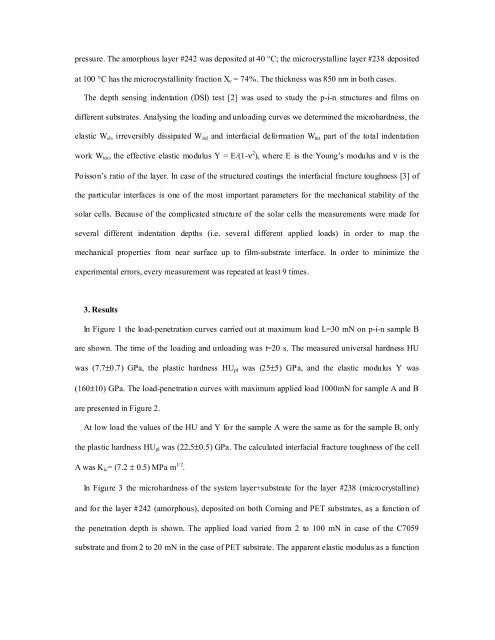Elsevier Editorial System(tm) for Journal of Non-Crystalline ... - Amper
Elsevier Editorial System(tm) for Journal of Non-Crystalline ... - Amper
Elsevier Editorial System(tm) for Journal of Non-Crystalline ... - Amper
Create successful ePaper yourself
Turn your PDF publications into a flip-book with our unique Google optimized e-Paper software.
pressure. The amorphous layer #242 was deposited at 40 °C; the microcrystalline layer #238 deposited<br />
at 100 °C has the microcrystallinity fraction Xc = 74%. The thickness was 850 nm in both cases.<br />
The depth sensing indentation (DSI) test [2] was used to study the p-i-n structures and films on<br />
different substrates. Analysing the loading and unloading curves we determined the microhardness, the<br />
elastic Wel, irreversibly dissipated Wird and interfacial de<strong>for</strong>mation Wint part <strong>of</strong> the total indentation<br />
work Wtot, the effective elastic modulus Y = E/(1-ν 2 ), where E is the Young’s modulus and ν is the<br />
Poisson’s ratio <strong>of</strong> the layer. In case <strong>of</strong> the structured coatings the interfacial fracture toughness [3] <strong>of</strong><br />
the particular interfaces is one <strong>of</strong> the most important parameters <strong>for</strong> the mechanical stability <strong>of</strong> the<br />
solar cells. Because <strong>of</strong> the complicated structure <strong>of</strong> the solar cells the measurements were made <strong>for</strong><br />
several different indentation depths (i.e. several different applied loads) in order to map the<br />
mechanical properties from near surface up to film-substrate interface. In order to minimize the<br />
experimental errors, every measurement was repeated at least 9 times.<br />
3. Results<br />
In Figure 1 the load-penetration curves carried out at maximum load L=30 mN on p-i-n sample B<br />
are shown. The time <strong>of</strong> the loading and unloading was t=20 s. The measured universal hardness HU<br />
was (7.7±0.7) GPa, the plastic hardness HUpl was (25±5) GPa, and the elastic modulus Y was<br />
(160±10) GPa. The load-penetration curves with maximum applied load 1000mN <strong>for</strong> sample A and B<br />
are presented in Figure 2.<br />
At low load the values <strong>of</strong> the HU and Y <strong>for</strong> the sample A were the same as <strong>for</strong> the sample B, only<br />
the plastic hardness HUpl was (22.5±0.5) GPa. The calculated interfacial fracture toughness <strong>of</strong> the cell<br />
A was Kic= (7.2 ± 0.5) MPa m 1/2 .<br />
In Figure 3 the microhardness <strong>of</strong> the system layer+substrate <strong>for</strong> the layer #238 (microcrystalline)<br />
and <strong>for</strong> the layer #242 (amorphous), deposited on both Corning and PET substrates, as a function <strong>of</strong><br />
the penetration depth is shown. The applied load varied from 2 to 100 mN in case <strong>of</strong> the C7059<br />
substrate and from 2 to 20 mN in the case <strong>of</strong> PET substrate. The apparent elastic modulus as a function
















